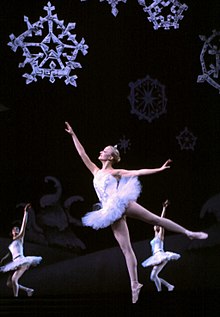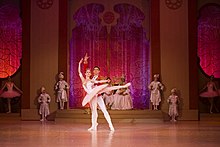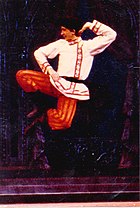The Nutcracker
![]()
The title of this article is ambiguous. For other meanings, see Nutcracker (disambiguation).
The Nutcracker, op. 71 (French: Casse-Noisette; Russian Щелкунчик, Shchelkunchik![]() ; English: The Nutcracker) is a fairy-tale ballet (French: Ballet-féerie) in two acts by Pyotr Ilyich Tchaikovsky, which had its world premiere in Saint Petersburg in 1892.
; English: The Nutcracker) is a fairy-tale ballet (French: Ballet-féerie) in two acts by Pyotr Ilyich Tchaikovsky, which had its world premiere in Saint Petersburg in 1892.
The libretto was based on Alexandre Dumas' Histoire d'un casse-noisette (1845), a French adaptation of the fairy tale Nutcracker and Mouse King by E. T. A. Hoffmann (1816).
The Nutcracker is still one of the most popular ballets today. It is regularly performed by many theatres and opera houses, usually appropriately around Christmas. Several musical numbers from the ballet are also famous through the Nutcracker Suite op. 71a.

Snowflake Waltz , performance by Rick Dikeman, 1981
.jpg)
Chinese Dance (Act 2), Kansas City Ballet, 2016

Pas de deux (Act 2) with Jelena Lečić and Andrej Kolčeriju, Serbian National Theatre, Novi Sad, 2011-2012
Content
People
(The indications follow the original libretto)
- President Silberhaus (in the Soviet-Russian tradition: "Stahlbaum") and his wife, parents of Klara and Fritz
- Klara (also: Claire or Marie (as in E.T.A. Hoffmann); in later Russian versions: Mascha), daughter of the Silberhaus family (original child role).
- Fritz, son of the Silberhaus family (original child role)
- Marianne, niece of President Silberhaus (original child role)
- Council Drosselmeier, godfather of Klara and Fritz
- The Nutcracker Prince
- Colombina and Harlequin (dolls)
- Sutler and soldier (dolls)
- the Mouse King
- the sugar fairy (Fée Dragée) (missing in some productions)
- Prince Coqueluche (missing in some productions)
- Soloists in the divertissement of the 2nd act
Relatives, children, servants, mice, snowflakes, fairies, flowers and others.
Storyline
The plot may differ in minor and major details in different productions: for example, in some modern Russian versions the Sugar Plum Fairy and Prince Coqueluche are missing. It is therefore not possible to give a completely universal account of the plot (see section: Performance history). The following plot is based on the original libretto.
Act 1, picture 1: In the house of the Silberhaus family
The ballet focuses on the girl Klara. She is the daughter of the wealthy Silberhaus family, who celebrate Christmas with many friends and relatives. Her godfather Drosselmeier also comes along for the big gift-giving. He is a clockmaker and inventor and impresses the whole family with wind-up figures. These can make music and even dance. After the performance, Drosselmeier has saved a little surprise: a magnificent nutcracker. Much to Klara's dismay, however, her brother Fritz damages the Nutcracker, which the sad girl then places in her doll's bed. After a general "grandfather dance", the guests take their leave.
In the middle of the night, Klara gets up to check on the sick Nutcracker. Everything is all spooky, the Christmas tree is getting bigger and the girl witnesses a battle between the toy soldiers led by the Nutcracker and the army of the Mouse King. When things look bad for the Nutcracker, Klara grabs a slipper and throws it at the Mouse King's head. The mice flee and the Nutcracker is transformed into a handsome young prince.
Act 1, picture 2: Winter fir forest
Then the scene transforms into a snow-covered fir forest. Klara and the Nutcracker Prince experience a waltz of snowflakes, which increases to a real snowstorm.
Act 2, picture 3: The Magic Palace of Jam Castle (Fantastic Decoration)
Across a river of rose water, the Nutcracker Prince and Klara reach "Jam Castle" (also called: "Empire of the Sugar Plum Fairy" or "Empire of Sweets"). The prince tells his four sisters and the others how Klara saved him. In a mood of relief, joy and gratitude, a fantastic feast begins, with a wide variety of dancers from all over the world giving spectacular performances. Russian dancers dance the Trepak, Arab belly dancers perform, dancing reed flutes (French: Mirlitons) and a group of Chinese acrobats appear and much more. Each country presents traditional delicacies and drinks. The crowning glory is a pas de deux dance by the Sugar Plum Fairy and her Cavalier (now often called Klara and the Nutcracker Prince, author's note). The feast ends with an elegant waltz by all present.
There are several variations for the ending:
- In the original libretto, the final apotheosis features a large beehive with bees buzzing around, guarding their honey. This is not normally performed like this today.
- It turns out that it was all a dream: Klara wakes up at the end and the Nutcracker is a puppet again (e.g. in Russian versions after Alexander Gorsky 1919, Vasily Vainonen 1934 (Mariinsky Ballet) and Juri Grigorowitsch 1966 (Bolshoi Ballet)).
- Klara travels back home in a reindeer sleigh, where she can sneak back into her crib without her family and siblings noticing (e.g., in Balanchine 1954 (New York City Ballet)).
.jpg)
Mother Cigogne and the Pulcinellas (Act 2), Kansas City Ballet, 2016.

Scene from Act 1, Ballet of the Serbian National Theatre, Novi Sad, 2011-2012
Cast and structure
Orchestration
3 flutes (2nd and 3rd also piccolo), 3 oboes (3rd cor anglais), 3 clarinets (1st and 2nd in A and B, 3rd bass clarinet). Bass clarinet), 2 bassoons, 4 horns in F, 2 trumpets in A and Bb, 3 trombones, tuba, timpani, percussion (3 players: cymbals, bass drum, tam-tam, triangle, tambourine, castanets, rattle, glockenspiel), celesta, 2 harps, strings.
Tchaikovsky's orchestration in the Nutcracker is very refined, colorful, and already impressionistic. There are some peculiarities: In the first picture, in the "Grandfather's Dance," a stage score of children playing appears, with obbligato toy trumpet and drums and toy cymbals and cuckoo and quail flutes (in C major) ad libitum. In addition, a gunshot is heard.
In the second picture, a two-part women's or children's choir sings a vocalise backstage in the "Snow Waltz".
The solo use of the celesta, which Tchaikovsky had only become acquainted with in Paris in the summer of 1891, is remarkable. The "Dance of the Sugar Plum Fairy" in the second act is one of the first compositions to use the instrument as part of the symphony orchestra and is still the best-known piece in the classical repertoire for celesta.
Structure
- Overture
- Act 1 - First Picture
- 1st Christmas Party. Decorating and lighting the Christmas tree
- Second march
- 3. small gallop of the children and appearance of the parents
- 4th Droßelmeier's Bescherung
- 5. presentation of the nutcracker and grandfather dance
- 6. farewell of the guests - night
- 7. battle of the mice and gingerbread soldiers
- Second picture
- 8. in the fir forest
- 9th Snowflake Waltz
- Act 2 - Third Picture
- 10. in the magic castle of jam castle
- 11. arrival of Klara and the Nutcracker Prince
- 12th divertissement
- a) Chocolate - Spanish Dance (Bolero)
- b) Coffee - Arabic dance
- c) Tea - Chinese dance
- d) Trepak - Russian dance
- e) Dance of the reed flutes
- f) Mother Cigogne and the Polichinelles
- 13th Flower Waltz
- 14. pas de deux
- a) Intrada
- b) Variation I: Tarantella
- c) Variation II: Dance of the Sugar Plum Fairy
- d) Coda
- 15th Valse finale and apotheosis

Stas Kmiec in Russian Dance (Trepak) (Act 2), 1985)
Questions and Answers
Q: What is the Nutcracker?
A: The Nutcracker is a classical ballet in two acts, based on E.T.A. Hoffmann's 1816 fairy tale The Nutcracker and the Mouse King.
Q: Who wrote the story for the ballet?
A: Ivan Vsevolozhsky and Marius Petipa adapted Hoffmann's story for the ballet.
Q: Who composed the music for it?
A: Pyotr Ilyich Tchaikovsky wrote the music for The Nutcracker.
Q: Who designed the dances?
A: Marius Petipa and Lev Ivanov designed the dances for The Nutcracker.
Q: When was it first performed?
A: The Nutcracker was first performed at the Mariinsky Theatre in St. Petersburg, Russia, on 18 December 1892 to a modest success and rarely seen in subsequent years.
Q: How did interest in this ballet grow over time?
A: Interest grew when Walt Disney used some of its music in his animated movie Fantasia, which led to an increased interest in this ballet; then George Balanchine's version of The Nutcracker was televised in late 1950s, further increasing its popularity around different places since then .
Q: What work did Tchaikovsky take from this ballet before its first performance ?
A: Before its first performance , Tchaikovsky took some numbers from this ballet to form what is now known as 'The Nutcracker Suite' , which became a great success on concert stages and is still played today .
Search within the encyclopedia